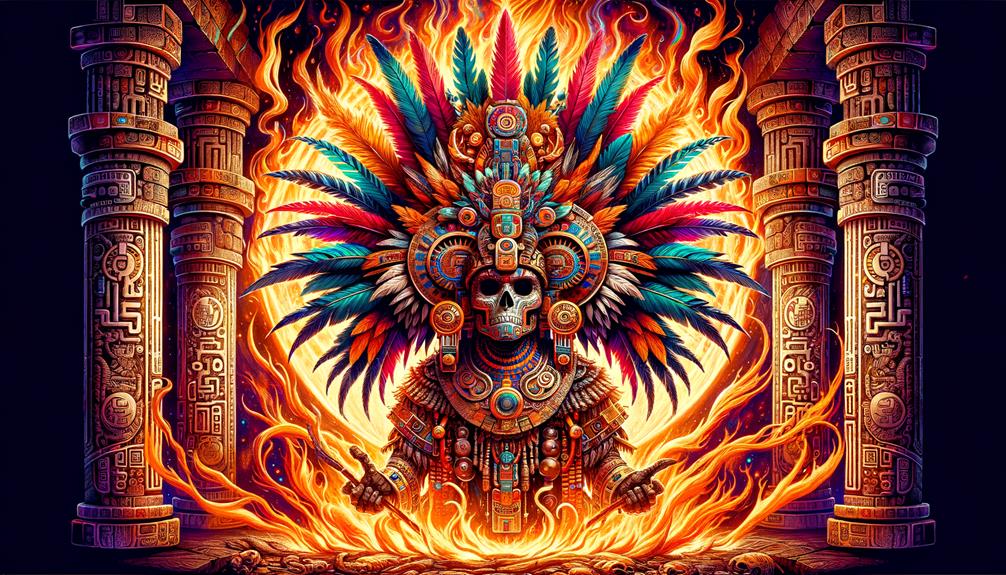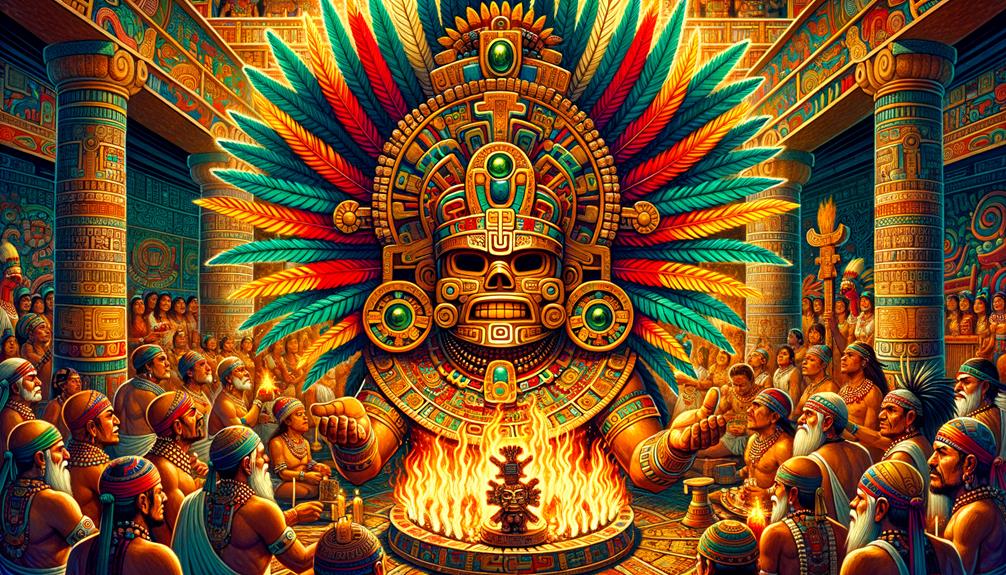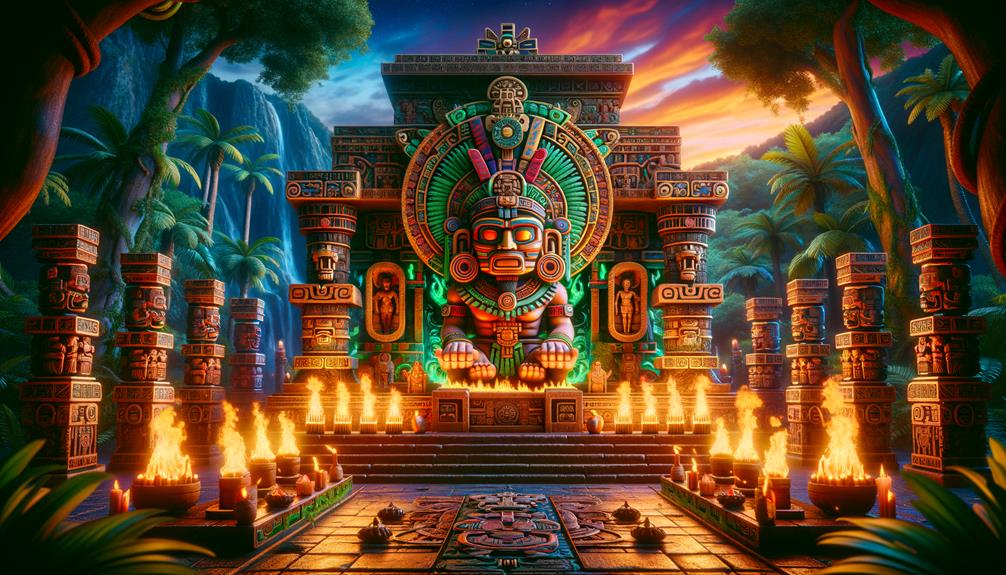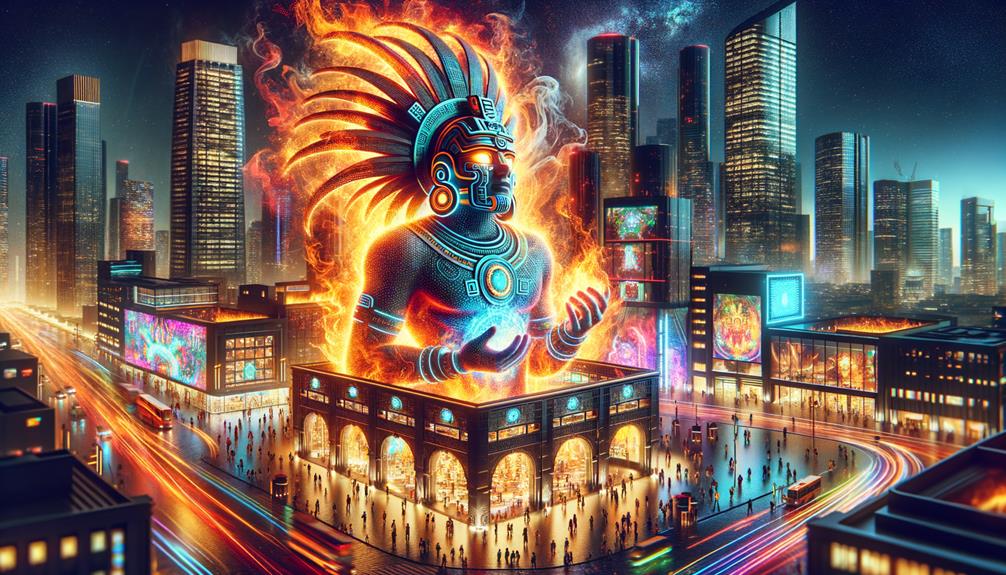Xiuhtecuhtli blazes brighter than the midday sun, embodying the perpetual rhythm of life, death, and rebirth. The Aztec deity of fire, adorned in turquoise with a greenstone shield and scepter, symbolizes creation's duality. Sacred rituals like the Izcalli festival and the New Fire Ceremony honor Xiuhtecuhtli's cosmic significance. Yet, what mysteries lie within this fiery lord's domain? Uncover the ancient tales of myth and rejuvenation surrounding this eternal flame.
Origins and Mythology
In the heart of ancient Mesoamerican folklore, Xiuhtecuhtli emerges as the eternal flame, embodying the essence of life, light, and renewal. As we explore the origins and mythology of this revered deity, we uncover Xiuhtecuhtli's profound significance: the Aztec Lord of Fire. Also known as the Old God or Huehueteotl, Xiuhtecuhtli's roots stretch deep into the ancient sands of Mesoamerican cultures, long before the Aztec civilization rose to prominence.
Xiuhtecuhtli transcends a mere god of fire; the deity represents the universe's heartbeat, the creator of all life. The flames symbolize the perpetual cycle of birth, death, and rebirth, sustaining the universe's delicate balance. In Aztec mythology, fire isn't just a destructive force; it's a source of warmth and hope, guiding souls through the cosmos.
Festivals honoring Xiuhtecuhtli reflect this sacred cycle. Through rituals and ceremonies, the Aztecs celebrated the god's power to regenerate and renew. Fire, both Old and New, became a crucial cultural element, symbolizing continuity and the eternal dance of life. Xiuhtecuhtli stands as a timeless guardian, a divine custodian of the flame that ignites existence itself.
Symbols and Depictions

Xiuhtecuhtli, the Aztec deity of fire, stands adorned with sacred symbols that reflect his divine essence. His likeness exudes power and significance, meticulously crafted with turquoise accents. A turquoise mask and mosaic adorn his face, linking him to the sacred fire and celestial realms.
Atop his head rests a brazier, signifying his dominion over flames. Feather tufts and a paper crown lend ceremonial grandeur, while copper bells tied to his feet announce his presence with every step. One hand grasps a greenstone shield, the other a scepter, marking his authority.
In symbolic form, Xiuhtecuhtli represents the sacrificial brazier central to the New Fire ceremony. His face, painted black and red, symbolizes creation and destruction's duality. Often depicted with a turquoise butterfly pectoral, he bridges myth and reality. Seven stars and a horned nose capture his celestial origins while grounding his mythical journey in the mortal realm.
Rituals and Ceremonies

The yearly ceremonies honoring Xiuhtecuhtli, the Fire Lord, intertwine cosmic renewal with earthly sacrifice, igniting a sacred flame that connects the heavens and mortal realms. During the Izcalli festival, we revere him through rituals and sacrifices to maintain the sacred fire. Priests, symbolizing divine and earthly bonds, lead these ceremonies, often marching up the Hill of the Star.
A significant ritual marks the end of a 52-year cycle – the New Fire Ceremony. Here, a new flame ignites, ensuring the cosmos continues turning. Sacrifices play a vital role; quails, representing purity and life, are offered, their blood sealing the bond between mortals and the divine.
The ceremonies culminate with the heart of a chosen individual torn out in a powerful devotional act. This heart kindles the sacred fire, a physical manifestation of reverence for the Fire Lord. As priests dance and sing, awaiting a specific star, they embody the eternal quest for cosmic renewal, a journey maintaining celestial harmony and honoring Xiuhtecuhtli's eternal flame.
Cultural Significance

Xiuhtecuhtli's presence in Aztec culture embodied the eternal clash between light and darkness, where fire signified both life's giver and its transformative force. As the Lord of Fire, this deity personified vitality and renewal. His image, often an elderly man carrying a flaming brazier on his head, mirrored the eternal flames fueling existence.
In the heart of Aztec society, Xiuhtecuhtli's sacred fire transcended the physical realm; it was a profound symbol of cosmic regeneration. The pivotal New Fire Ceremony ensured the world's continuity. During this ritual, the Aztecs extinguished all fires, plunging their world into symbolic darkness, only to reignite them from a single, purified flame. This act wasn't merely practical but a profound renewal of their cosmic order.
Influence in Modern Media

Modern media immerses viewers in the ancient Aztec mythology, breathing life into the fiery deity Xiuhtecuhtli. As Lord of Fire, his formidable presence inspires authors, filmmakers, and game developers to reimagine his role. Literature delves into the symbolism of destruction and rebirth, exploring life's cyclical nature through Xiuhtecuhtli's legend. Visually captivating movies and games draw from the same cultural wellspring, rendering his primal energy with stunning visuals.
Across mediums, contemporary artists pay homage to this timeless god, ensuring his mythic fire resonates anew. Xiuhtecuhtli's enduring legacy proves ancient stories continue inspiring humanity, igniting the imagination with tales of transformation and warmth. Through inventive storytelling, his legend blazes brightly, bridging past and present in an ever-evolving tapestry of creativity.
Frequently Asked Questions
What Is Xiuhtecuhtli the God Of?
As flames dance, I embody creation's rhythmic ebb and flow. Guiding souls beyond this realm, my rituals mirror the cosmos' eternal cycles – bestowing warmth, illumination, and vibrant renewal. The sacred fire within ignites transformation, breathing life into the path ahead.
Who Is the God of Fire in Teotihuacan?
In Teotihuacan, the elderly fire god wears a brazier atop his head, an eternal flame symbol. This fire embodies the ceaseless cycle of creation and destruction central to life's forces. As souls move on, the flame guides them while fueling the universe's continuity.
Who Is the Mayan God of Fire?
Who kindles the spark of life and creation in the Mayan world? Xiuhtecuhtli, the ancient fire deity, symbolizes vitality, renewal, and illumination in their mythology. A revered figure of warmth and light, Xiuhtecuhtli stands as a prominent force in Mayan beliefs and traditions. This fire god represents the vibrant energy that sustains and transforms the Mayan universe.
Who Is the God of Fire in Egypt?
In Egypt, Sekhmet reigns as the fearsome fire goddess. Her lioness form embodies raw power – both destructive and restorative. She scorches with furious flames yet balances humanity, guiding mortals through life's trials.


